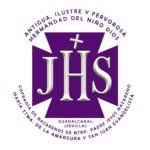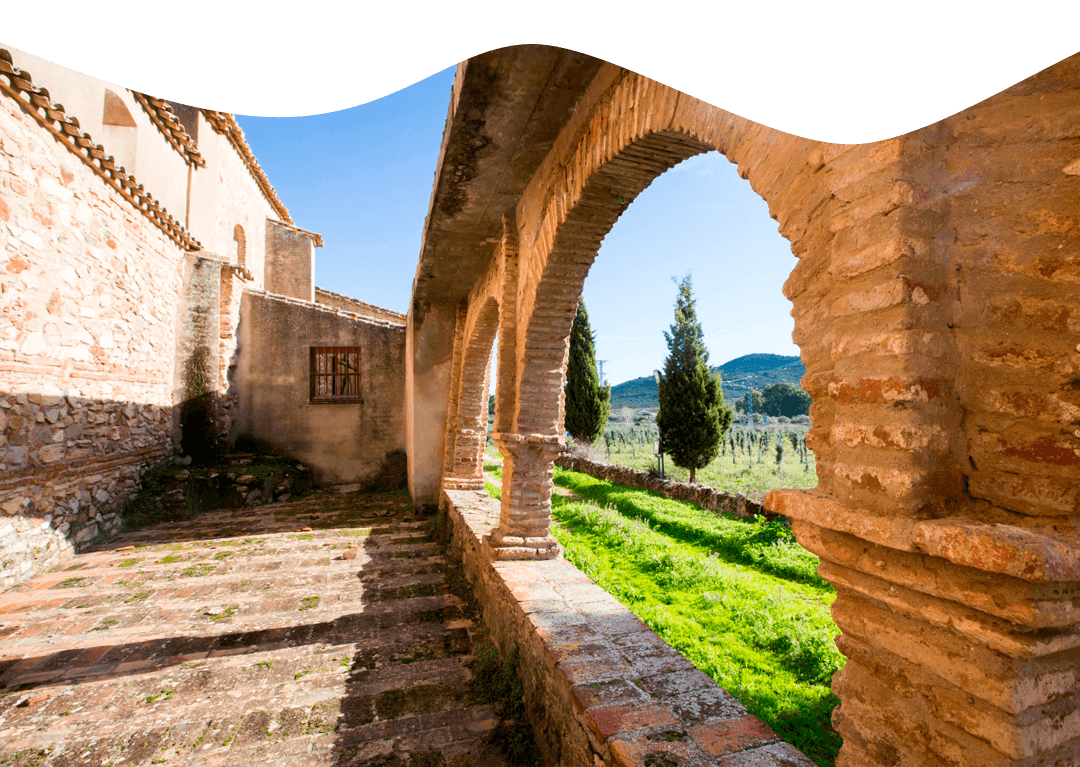Ancient and Fervent Brotherhood of the Child God
y Cofradía de Nazarenos de Nuestro Padre Jesús Nazareno, María Santísima de La Amargura y San Juan Evangelista.

Coat of arms
Our corporation was officially founded in 1504 in the old Parish Church of San Sebastián, as the Brotherhood of the Child God, venerating this sacred patron saint since its origin.
There is documentation from the year 1565. The brotherhood has an account book from 1644 which reflects the visit of the Prior of the Royal Convent of San Marcos de León in 1642, and in it the presentation of the aforementioned book, as well as the old one, is required.
The first rules of the confraternity were approved in 1580, the current ones are from 2020.
According to information gathered from the encyclopaedia of Holy Week in Seville, shortly after its foundation in the 16th century, the brotherhood acquired an image of Jesus the Nazarene with the cross on his shoulder, and this image became the patron saint of the brotherhood. It is also known that the brotherhood owned an image of the Blessed Virgin, called the “Dolorosa” in the archives of the brotherhood, and a sculpture of Mary Magdalene, who was also the patron saint of the original brotherhood.
In 1936 the brotherhood lost its images due to the civil war.
It also abandoned its foundational headquarters in the Parish Church of San Sebastián when it was sold by the ecclesiastical authority to the Town Hall, the current owner. Since then the brotherhood has been canonically established in the Parish Church of Santa María de la Asunción.
Relevant data
Image of the Child God. Donated by Carmen Nogales Romero in 1950.
Our Father Jesus of Nazareth.
On 5th July 1935 the brotherhood signed a contract with the sculptor Mr. José Fernández Andes for the creation of the image of the Lord, which was received in 1939. It was restored in 2003 by Professor Juan Manuel Miñarro.
In 1976 the wooden tree cross was donated to the Brotherhood, and years later another one made of lighter material was acquired so as not to damage the image.
The current cross was made by Don Gonzalo Merencio Álvarez in 2015, it has golden corners made by the goldsmith Don Juan Cantero and was donated by a group of brothers.
María Santísima de la Amargura.
In 1943 the brotherhood acquired the image of María Santísima de la Amargura, the work of the sculptor Antonio Illanes.
It was restored in 1999 by Professor Juan Manuel Miñarro López.
Saint John the Evangelist.
In 1954 the image of Saint John the Evangelist by the artist Antonio Castillo Lastrucci was donated to the Brotherhood by Carmen Rivero Rivero. Since then it has been carried in procession with the Virgin of La Amargura in her paso de palio.
The image was restored in 1998 and in 2021, on both occasions the restoration work was carried out by professor Juan Manuel Miñarro López.
Simon the Cyrenean.
The Cirineo was acquired in 1948 from the Hermandad de los Panderos de Sevilla where he was Santiago Apóstol. It accompanied Our Father Jesus for the first time in 1949.
It is believed to be from the workshop of Juan de Astorga, between 1818 and 1819.
It was restored in 2016 by Juan Manuel Romero Hernández.
PASOS
The float of Our Father Jesus of Nazareth.
The current float of the Lord is from 2003, it was carved by Don Gonzalo Merencio Álvarez in real cedar wood. The canastilla is of baroque style with cartouches on the corners, sides and front.
It was gilded in the workshops of Don Manuel Calvo.
It carries 32 bearers.
The float of María Santísima de la Amargura.
It was made in 1999 by the goldsmith Don Manuel de los Ríos, it is made of silver plated alpaca. It has 12 poles of chiselled and silver-plated metal. The canopy is made of velvet donated by Manuel Fernández and embroidered by Miguel Ángel León, María José Chávez and Rafaela Barragán. Candelaria in carved silver.
It carries 28 bearers.
TROUSSEAU OF OUR INCUMBENTS
Lord's trousseau
It has an extensive trousseau with the following highlights:
- Purple tunic embroidered in gold.
Persian tunic dating from 1740. It was restored in 2013 by the employment workshop “Monforte” of the Guadalcanal Town Council, directed by Mr. - José Diego Sianes Blanco and teachers Ms. Eva María Díaz Melero and Ms. M Carmen Muñoz Martín.
It also has several purple and burgundy tunics.
Tortoiseshell cross. The silver butt plates and finials were acquired in 1784, when D. José Gil was the Steward.
It has 3 sets of potencias, one golden for the chapel and two for the exits, some in gold and others in silver. In addition, 2 more sets of the old image are preserved.
It has three golden cords and one silver exit cord. In addition to 2 more of the old image.
It has several sets of cufflinks:
- Leather cufflinks.
Three pairs of gold cufflinks. - Silver cufflinks with the image of the Virgen del Rocío donated by Fernando Flores Muñoz in 2013.
- Silver cufflinks with the inscription JHS, donated by María del Rosario Muñoz López in 2019.
- Gold Medal of the Guadalcanal Town Council for the 75th anniversary of the carving of the Lord and the medal of the patron saint, Our Lady of Guaditoca.
Trousseau of Mary Most Holy of Sorrow
We can highlight.
- Blue velvet cloak purchased by the Brotherhood.
- White mantle with pink brocade bought by the Brotherhood.
- Purple velvet mantle embroidered in silver, embroidered by Francisco Carrera Iglesias, donated by Miguel Ángel León and made by Felisa Gordon.
- Bordeaux velvet mantle embroidered in gold by Miguel Ángel León, made by Felisa Gordon and donated by Manuel Fernández and family.
- Black mantle brocaded in gold donated by Miguel Ángel León and Rafaela Barragán and made by Rafaela Barragán.
- White mantle brocaded in gold donated by a group of brothers and made by Rafaela Barragán.
- Red mantle brocaded in gold, donated and made by Rafaela Barragán.
- Purple saya embroidered in silver, embroidery transferred by Francisco Carrera Iglesias and paid for by a group of brothers and sisters, made by Felisa Gordon.
- Bordeaux saya embroidered in gold by Miguel Ángel León and made by Rafaela Barragán and donated by both.
- Blue saya embroidered in gold by Miguel Ángel León and made by Manuela Duran.
- White tissue saya donated by Francisco Villaverde and Penélope Romero, embroidered by Rafaela Barragán and made by Mari Carmen Atalaya.
- Two crowns of silver on gold, a golden Hebrew ring, a golden diadem and a silver diadem.
- Silver crescent. Restored by the goldsmith Juan Cantero Gordon in 2013.
- Gold medal given by the Brotherhood of Our Lady of Guaditoca to María Santísima de la Amargura for its 75th Anniversary.
Trousseau of Saint John the Evangelist
Highlights.
- Purple velvet tunic embroidered in gold.
- Plain purple velvet tunic donated by a brother and several other tunics.
- Green velvet shawl embroidered in gold and several others of different colours.
The Christ Child's trousseau
We can highlight:
- Purple velvet tunic.
Bordeaux tunic brocaded in gold. - White embroidered tunic and two other very old brocades.
A set of powers in gold.
Annual services
As our sacred rules state, the annual worship services are as follows: In January, a service is held for the Child of God, the primitive patron saint of the Brotherhood. On the first Monday of Lent, the Solemn Quinary to our titular saints begins, culminating on the Saturday of the same week with the Main Function of the Institute. Station of Penitence. This takes place in the early hours of Good Friday morning, beginning at 5 a.m. and finishing at about 10.30 in the morning. In July we hold a Solemn Triduum in honour of María Santísima de la Amargura.
Itinerary of the Stations of Penitence
Departure, Plaza de España, Muñoz Torrado, Mesones, Antonio Porras, Santiago, San Sebastián, Guaditoca, Antonio Machado, Costalero, Andrés Mirón, Granillos, Espíritu Santo, López de Ayala, Mesones, Muñoz Torrado, Juan Campos, Santa Clara, Avenida Constitución, Palacio, Plaza de España, Pick up.
Habito de nazarenos:
Purple tunic and purple hood and gold cincture in the paso of Christ.
White tunic, purple hood and cape with gold cincture in the paso de Palio.
Marches dedicated to our incumbents.
“Lágrimas de Amargura”. (2007). Francisco Javier Carrasco Jiménez.
“Suspiros de Madrugá”. Mario Morillo Ugía.
“Amargura en tu amanecer”. (2015). Ignacio Caballero Murillo
“Padre Jesús” Al Señor de Guadalcanal. (2009). José Ángel Fontecha Vázquez y Mario Fontecha Vázquez.
“Con tu cruz entre mis brazos” (2017). Oscar J. Ruiz Delgado. Dedicada a un hermano y costalero.
“Tu esencia en el alba”. Juan Vicente Joya Páez.
Other information of interest.
In the 17th century, in addition to the Stations of Penitence on Good Friday, a series of theatrical events were held, with the character of an auto sacramental.
The Brotherhood has a Roman centuria that accompanied Our Father Jesus of Nazareth from 1903 to 1994. In 2022 a representation of the centuria accompanied the Lord, we hope to increase the number in the coming years.
.
Until 1936, the images of Our Father Jesus of Nazareth and Our Lady of Sorrow were accompanied by the image of St. Mary Magdalene.
In 1979, the first group of costaleros of Guadalcanal was formed.
In 1979, the first group of costaleros from Guadalcanal was formed and they took Our Father Jesus out for the first time.
In 2004, various events were held to commemorate the V Centenary of the founding of the Brotherhood, among which the following stand out:
In February Solemn Stations of the Cross with the image of the Lord from the parish church of Santa María de la Asunción to the Church of the Convent. The following day it made the inverse route in its departure procession.
El 15 de agosto, salida extraordinaria de María Santísima de la Amargura por las calles de Guadalcanal acompañada por la Banda de Música Ntra. Sra. de Guaditoca. Se grabó en directo un doble cd.
En el año 2014 se cumplieron 75 años de la talla de la imagen del Señor. Durante ese año se organizaron varios actos para conmemorar tan importante fecha.
Se editó un cartel conmemorativo.
On 3 October 2004, a community prayer was organised, presided over by the image of our patron saint.
The most important of these took place on 4 October in the Parish Church of Santa María de la Asunción. On the afternoon of that day, the Gold Medal of the Town of Guadalcanal was awarded to Our Father Jesus of Nazareth. It is a medal for 75 years of faith, devotion and love for the Nazarene of the Madrugá.


